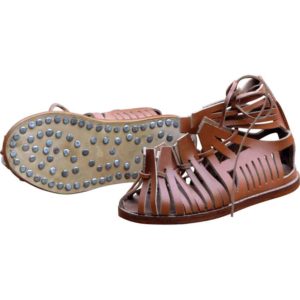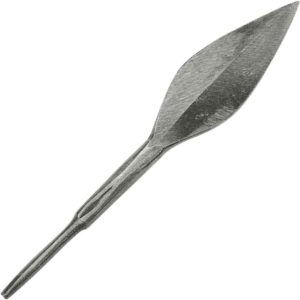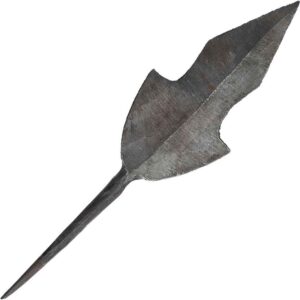Spanish Fluted Cup Rapier
$151.15
Rapiers came in all sorts of different hilt styles, many of them divided up by the regions they were favored in. This Spanish Fluted Cup Rapier leaves little question as to where its design originated from, or where its design was most popular. Despite being Spanish in origin, the cup hilt became popular in a number of other areas as well, and could be as far-reaching as any of the other styles of rapier hilts. On this particular recreation, the rapier blade is hand crafted entirely in carbon steel, with a long ricasso and a diamond cross-section, which offers blade-stiffness and rigidity for both thrusting and parrying. The cup hilt is fluted in design, and provides a solid plate of protection for the sword-hand, while the guard itself also features straight bar quillons, and a knuckle-guard, for added hand defense. The grip is wrapped in leather and inlaid with red wiring for greater appeal, and the hilt is topped with a grooved sphere pommel, which continues the detailing of the guard and completes the swords look nicely. The detailing and overall shape of this Spanish Fluted Cup Rapier make it a solid choice for any musketeer to own and wield, and it will not fail to serve well either as a sword to carry in your renaissance costume or display in your collection of arms.
Key Features:
- Fully Functional
- A Renaissance Style Rapier Sword
- Blade Features an Unsharpened Edge
- Has an Elegant Cup Style Hilt with Fluting Details
- Includes a Wooden, Leather Wrapped Scabbard
Materials:
- The Blade is Made from EN45 High Carbon Steel
Care Instructions:
- Check out our Sword Care and Maintenance Guide for all kinds of info on how to take care of your sword and keep it in its best shape.

| Overall Length | Blade Length | Weight | |
|---|---|---|---|
| One Size | 41 inches | 33.5 inches | 2.75 pounds |
1 review for Spanish Fluted Cup Rapier
Only logged in customers who have purchased this product may leave a review.
Related products
-
Roman Caligae
SKU: AH-3872$122.15 Add to Cart This product has multiple variants. The options may be chosen on the product pageRated 5.00 out of 5 -
Thin Leaf Dart Arrowhead
SKU: AH-3522-18$12.42 Add to Cart This product has multiple variants. The options may be chosen on the product pageRated 0 out of 5 -
Steel German Sallet
SKU: AH-4133$156.19 – $193.99Price range: $156.19 through $193.99 Add to Cart This product has multiple variants. The options may be chosen on the product pageRated 4.67 out of 5 -
Waisted Broadhead Arrowhead
SKU: AH-3522-7$8.50 Add to Cart This product has multiple variants. The options may be chosen on the product pageRated 0 out of 5












kuntz1 (verified owner) –
I am first and foremost, a medieval 15th-Century longsword student, practitioner, and enthusiast; that being said, this Spanish Fluted Cup Rapier is wonderful to behold, and wonderful to use!
I wanted an example of the rapier sword for my collection; just as a “type model”, as I am collecting certain swords to illustrate with the collection, the evolution of the sword through time.
I truthfully did not allow myself to “look eagerly forward” to the arrival of this rapier, given the price, and given the rapier-style.
My “collecting parameters” for this sword (and every sword in my collection): is that the sword must be fully functional, high-carbon steel, and represent a distinct style from a period in history. This Spanish Fluted Cup Rapier fills the bill for all parameters; but also turns out to be quite beautiful as well!
Well made and solid, the blade is slender and wicked (needs sharpening), and the fluted cup guard is very cool looking, as well as functional. I love the extended long crossguard, with its ball-tipped quillons; common to many Italian and Spanish rapiers. The simple “D” configured knuckle-guard, is both elegant and functional.
The leather wrapped handle also has a wire wrapped decoration which also aids the fencer’s grip.
This sword is quite beautiful, and that is achieved through simple, functional, elegance. I love the feel of it in my hand, and the quickness of the narrow wicked rapier blade.
So don’t let the price fool you as it did me; this Spanish Fluted Cup Rapier is a quality rapier.
It has also inspired me to want to better learn the rapier sword in fencing.
I fenced in military high school: but sport fencing is fundamentally different than actually fencing for one’s life with a cut and thrust, thin, rapier blade. The sport fencing foil, saber, etc. are also fairly different than the rapier of the renaissance, and the fencing saber isn’t what most people envision when they think of a ‘saber’.
I know also now, after buying this sword, that this will only be my first rapier purchase; (and not just a lonely era-sample, as I first intended).
Rapiers are just quite beautiful, with their thin, quick, and lively, blades and their often elaborate hilt guards.
This is a fine sword, and I happily give it 5-Stars!!